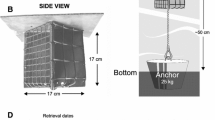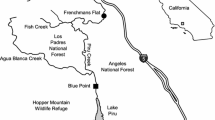Abstract
A few years after it invaded, the amphipod Corophium curvispinum Sars appeared to be the most numerous macroinvertebrate species in the River Rhine. From 1987 to 1991 the densities of this species on the stones of groins in the Lower Rhine at a depth of 0.5 m increased from 2 to 200000 specimens per m2. In the Lower Rhine and its branches the densities of C. curvispinum increased with increasing current velocities and with increasing water depths. So far, a maximum population density of 750000 specimens per m2 has been found in the Lower Rhine, which is many times the densities recorded elsewhere. Population parameters, densities and distribution of C. curvispinum were studied in the Lower Rhine and its branches, using artificial substrates and sampling stones from groins. The success of this immigrant is related to its competitive strategy, which shows several aspects of a r-strategy. In addition, the heavily eutrophicated Lower Rhine provides abundant food (phytoplankton, suspended organic matter) for this opportunistic filter-feeder. The increased salinity and water temperatures in the Lower Rhine resulting from industrial discharges have contributed to the current success of this southern species originating in brackish waters. The very high densities of C. curvispinum might have an enormous impact on the river ecosystem by changing food webs.
Similar content being viewed by others
References
Admiraal W, Van der Velde G, Smit H, Cazemier WG (1993) The rivers Rhine and Meuse in The Netherlands: present state and signs of recovery. Hydrobiologia, in press
Bayliss D, Harris RR (1988) Chloride ion regulation in the fresh-water amphipod Corophium curvispinum and acclimatory effects of external Cl−. J Comp Physiol B 158:81–90
Behning A (1914) Corophium curvispinum G.O. Sars und seine geographische Verbreitung. Zool Jahrb Zeitschr Syst Geogr Biol 37:385–400
Bergers PJM (1991) Voedselecologie van vissen in de Nederlandse Rijntakken. Publications and reports of the project ‘Ecological Rehabilitation of the River Rhine’ 28–1991:1–119
Bortkewitch LW (1987) Ecology and production of Corophium curvispinum G.O. Sars in the estuary areas of rivers in the northwestern Black Sea area. Gidrobiol Zh 23:91–93
Bij de Vaate A (1991) Distribution and aspects of population dynamics of the zebra mussel, Dreissena polymorpha (Pallas, 1771), in the lake IJsselmeer area (The Netherlands). Oecologia 86:40–50
Bij de Vaate A, Greijdanus-Klaas M (1990a) The Asiatic clam, Corbicula fluminea Müller, 1774 (Pelecypoda, Corbiculidae), a new immigrant in the Netherlands. Bull Zool Mus Amsterdam 12:173–178
Bij de Vaate A, Greijdanus-Klaas M (1990b) Biologische monitoring van rivieren met kunstmatig substraat. Institute for Inland Water Management and Waste Water Treatment, report nr. 90.009, pp 1–57, Lelystad
Bij de Vaate A, Greijdanus-Klaas M (1991) Monitoring macroin-vertebrates in the River Rhine. Publications and reports of the project ‘Ecological Rehabilitation of the River Rhine’ 27–1991:1–39
Den Hartog C, Van der Velde G (1987) Invasions by plants and animals into coastal, brackish and fresh water of the Netherlands. Proc K Ned Akad Wet C 90:31–37
Den Hartog C, Van den Brink FWB, Van der Velde G (1989) Brackish-water invaders in the River Rhine: a bioindication for increased salinity level over the years. Naturwissenschaften 76:80–81
De Ruyter van Steveninck ED, Admiraal W, Van Zanten B (1990) Changes in plankton communities in regulated reaches of the Lower River Rhine. Regulated Rivers: Res Manage 5:67–75
D'Udekem d'Acoz C, Stroot P (1988) Note sur l'expansion de Corophium curvispinum Sars, 1895 en Meuse (Crustacea, Amphipoda: Corophiidae). Ann Soc R Zool Belg 118:171–175
Fish JD, Mills A (1979) The reproductive biology of Corophium volutator and C. arenarium (Crustacea: Amphipoda). J Mar Biol Ass UK 59:355–368
Frantzen N (1991) De kwaliteit van Maas- en Rijnwater in de periode 1983–1989. RIWA report 1991 Amsterdam, pp 1–105
Hanssen AEJ (1991) Voedselgegevens van riviervissen en riviertrek-vissen afkomstig uit de Nederlandse Rijntakken. Report (unpublished) Laboratory of Aquatic Ecology, Nymegen
Harris RR, Bayliss D (1990) Osmoregulation in Corophium curvispinum (Crustacea: Amphipoda), a recent colonizer of fresh-water. III. Evidence for adaptive changes in sodium regulation. J Comp Physiol B 160:85–92
Jazdzewski K (1980) Range extensions of some gammaridean species in European inland waters caused by human activity. Crustaceana Suppl 6:84–107
Klink AG (1990) Drift van macro-evertebraten in de Maas. RIZA report nr. 90.071 Lelystad, pp 1–45
Klink AG, Moller-Pillot H (1982) Onderzoek aan de makro-evertebraten in de grote Nederlandse rivieren. Hydrobiologisch Adviesburo Klink BV, Wageningen: 1–57
Möller P, Rosenberg R (1982) Production and abundance of the amphipod Corophium volutator on the west coast of Sweden. Neth J Sea Res 16:127–140
Moore PG (1981) The life histories of the amphipods Lembos websteri Bate and Corophium bonnelli Milne Edwards in kelp holdfasts. J Exp Mar Biol Ecol 49:1–50
Muskó IB (1989) Amphipoda (Crustacea) in the littoral zone of Lake Balaton (Hungary). Qualitative and quantitative studies. Int Rev Ges Hydrobiol 74:195–205
Muskó IB (1990) Qualitative and quantitative relationships of Amphipoda (Crustacea) living on macrophytes in Lake Balaton (Hungary). Hydrobiologia 191:269–274
Peeters ETHM (1988) Hydrobiologisch onderzoek in de Maas. Report Department Nature Conservation, Agricultural University Wageningen, The Netherlands
Petts GE (1989) Historical change of large alluvial rivers. Western Europe, Wiley, London
Pygott JR, Douglas S (1989) Current distribution of Corophium curvispinum Sars var devium Wundsch (Crustacea: Amphipoda) in Britain with notes on its ecology in the Shropshire Union canal. Naturalist 114:15–17
Schellenberg A (1942) Die Tierwelt Deutschlands 40 (IV): Flohkrebse oder Amphipoda, Gustav Fischer, Jena
Schiller W (1990) Die Entwicklung der Makrozoobenthonbesiedlung des Rheins in Nordrhein-Westfalen im Zeitraum 1969–1987. In: Kinzelbach R, Friedrich G (eds) Biologie des Rheins, Limnol Aktuell 1:259–275
Schöll F (1990) Zur Bestandssituation von Corophium curvispinum, Sars im Rheingebiet. Lauterbornia 5:67–70
Sebestyén O (1934) Appearance and rapid increase of Dreissensia polymorpha Pall. and Corophium curvispinum G.O. Sars forma devium Wundsch in Lake Balaton. Arb Ungarisch Biol Forsch Inst 7:190–202
Sebestyén O (1938) Colonization of two new fauna-elements of Pontus-origin (Dreissensia polymorpha Pall. and Corophium curvispinum G.O. Sars forma devium Wundsch) in Lake Balaton. Verh Int Ver Limnol 8:169–182
Sheader M (1978) Distribution and reproductive biology of Corophium insidiosum (Amphipoda) on the north-east coast of England. J Mar Biol Ass UK 58:585–596
Sokal RR, Rohlf FJ (1981) Biometry. The principles and practice of statistics in biological research, Freeman, San Francisco
Tittizer T, Schöll F, Schleuter M (1990) Beitrag zur Struktur und Entwicklungsdynamik der Benthalfauna des Rheins von Basel bis Düsseldorf in den Jahren 1986 und 1987. In: Kinzelbach R, Friedrich G (eds) Biologie des Rheins. Limnol Aktuell 1:293–323
Taylor PM, Harris RR (1986a) Osmoregulation in Corophium curvispinum (Crustacea: Amphipoda), a recent colonizer of fresh-water. I. Sodium ion regulation. J Comp Physiol B 156:323–329
Taylor PM, Harris RR (1986b) Osmoregulation in Corophium curvispinum (Crustacea: Amphipoda), a recent colonizer of fresh-water. II. Water balance and the functional anatomy of the antennary organ. J Comp Physiol B 156:331–337
Van den Brink FWB, Van der Velde G (1986a) Observations on the seasonal and yearly occurrence and the distribution of Atyaephyra desmaresti (Millet, 1831) in The Netherlands. Hydrobiol Bull (Amsterdam) 19:193–198
Van den Brink FWB, Van der Velde G (1986b) Observations on the population dynamics and distribution of the White Prawn Palaemon longirostris H. Milne Edwards, 1837 (Crustacea, Decapoda, Natantia) in The Netherlands, with special reference to its occurrence in the major rivers. Arch Hydrobiol 107:465–495
Van den Brink FWB, Van der Velde G (1992) Slijkgarnalen (Crustacea: Amphipoda: Corophiidae) in Nederland. Zeepaard 52:32–37
Van den Brink FWB, Van der Velde G, Geelen JFM (1988) Life history parameters and temperature-related activity of an American crayfish, Orconectes limosus (Rafinesque, 1817) (Crustacea, Decapoda), in the area of the major rivers in The Netherlands. Arch Hydrobiol 114:275–289
Van den Brink FWB, Van der Velde G, Bij de Vaate A (1989) A note on the immigration of Corophium curvispinum Sars, 1895 (Crustacea: Amphipoda) into the Netherlands via the River Rhine. Bull Zool Mus Amsterdam 11:211–213
Van den Brink FWB, Van der Velde G, Cazemier WG (1990) The faunistic composition of the freshwater section of the River Rhine in The Netherlands: present state and changes since 1900. In: Kinzelbach R, Friedrich G, (eds) Biologie des Rheins. Limnol Aktuell 1:192–216
Van den Brink FWB, Van der Velde G, Bij de Vaate A (1991a) Amphipod invasion on the Rhine. Nature 352:576
Van den Brink FWB, Van der Velde G, Bij de Vaate A (1991b) Slijkgarnaal bedreigt Rijnfauna. Bionieuws 1:7
Van der Velde G, Van den Brink FWB, Van der Gaag M, Bergers PJM (1990) Changes in numbers of mobile macroinvertebrates and fish in the River Waal in 1987, as studied by sampling cooling-water intakes of a power plant: first results of a Dutch Rhine biomonitoring project. In: Kinzelbach R, Friedrich G (eds) Biologie des Rheins. Limnol Aktuell 1:325–342
Van der Velde G, Van Urk G, Van den Brink FWB, Colijn F, Bruggeman WA, Leuven RSEW (1991) Rein Rijnwater, een sleutelfactor in chemisch oecosysteemherstel. In: Hekstra GP, Van Linden FJM (eds) Flora en fauna chemisch onder druk. Pudoc, Wageningen, pp 231–266
Van Urk G (1978) The macrobenthos of the River IJssel. Hydrobiol Bull 12:21–29
Van Urk G (1984) Lower Rhine-Meuse. In: Whitton BA (ed) Ecology of European rivers. Blackwell, Oxford, pp 437–468
Van Urk G, Bij de Vaate A (1990) Ecological studies in the Lower Rhine in the Netherlands. In: Kinzelbach R, Friedrich G (eds) Biologie des Rheins. Limnol Aktuell 1:131–145
Wouters K (1985) Corophium curvispinum Sars, 1895 (Amphipoda) in the River Meuse, Belgium. Crustaceana 48:218–220
Author information
Authors and Affiliations
Rights and permissions
About this article
Cite this article
van den Brink, F.W.B., van der Velde, G. & bij de Vaate, A. Ecological aspects, explosive range extension and impact of a mass invader, Corophium curvispinum Sars, 1895 (Crustacea: Amphipoda), in the Lower Rhine (The Netherlands). Oecologia 93, 224–232 (1993). https://doi.org/10.1007/BF00317675
Received:
Accepted:
Issue Date:
DOI: https://doi.org/10.1007/BF00317675




